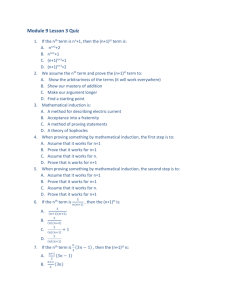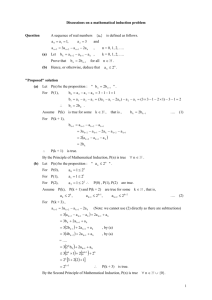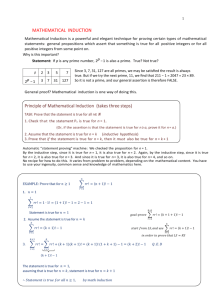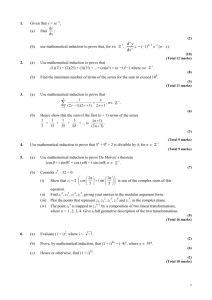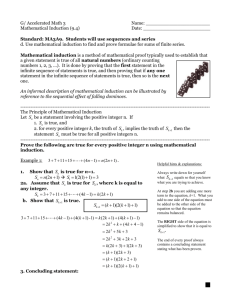Different kinds of Mathematical Inductions
advertisement
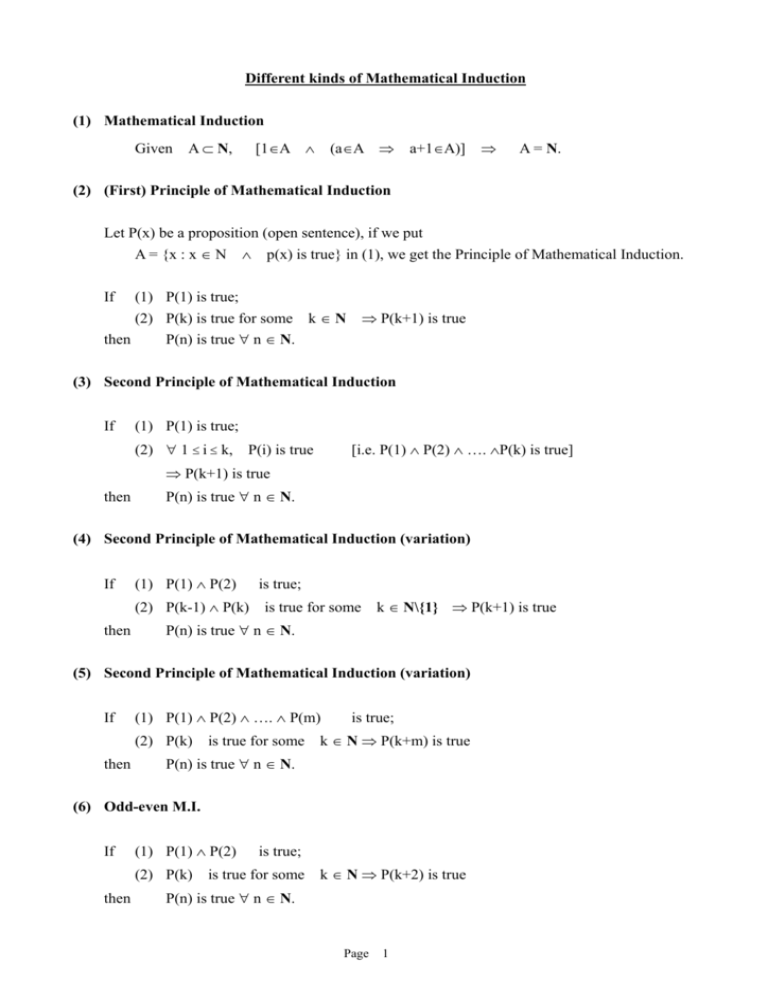
Different kinds of Mathematical Induction
(1) Mathematical Induction
Given
A ⊂ N,
[1∈A ∧
(a∈A ⇒ a+1∈A)]
⇒
A = N.
(2) (First) Principle of Mathematical Induction
Let P(x) be a proposition (open sentence), if we put
A = {x : x ∈ N ∧
If
p(x) is true} in (1), we get the Principle of Mathematical Induction.
(1) P(1) is true;
(2) P(k) is true for some k ∈ N ⇒ P(k+1) is true
then
P(n) is true ∀ n ∈ N.
(3) Second Principle of Mathematical Induction
If
(1) P(1) is true;
(2) ∀ 1 ≤ i ≤ k, P(i) is true
[i.e. P(1) ∧ P(2) ∧ …. ∧P(k) is true]
⇒ P(k+1) is true
then
P(n) is true ∀ n ∈ N.
(4) Second Principle of Mathematical Induction (variation)
If
(1) P(1) ∧ P(2)
(2) P(k-1) ∧ P(k)
then
is true;
is true for some
k ∈ N\{1} ⇒ P(k+1) is true
P(n) is true ∀ n ∈ N.
(5) Second Principle of Mathematical Induction (variation)
If
(1) P(1) ∧ P(2) ∧ …. ∧ P(m)
(2) P(k)
then
is true for some
is true;
k ∈ N ⇒ P(k+m) is true
P(n) is true ∀ n ∈ N.
(6) Odd-even M.I.
If
(1) P(1) ∧ P(2)
(2) P(k)
then
is true;
is true for some
k ∈ N ⇒ P(k+2) is true
P(n) is true ∀ n ∈ N.
Page
1
More difficult types of Mathematical Induction
(7) Backward M.I.
If
(1) P(n) is true ∀ n ∈ A, where A is an infinite subset of N;
k∈N
(2) P(k) is true for some
then
⇒ P(k–1) is true
P(n) is true ∀ n ∈ N.
(8) Backward M.I. (variation) (more easily applied than (7))
If
(1) P(1) is true;
k ∈ N ⇒ P(2k+1) is true;
(2) P(2k) is true for some
k∈N
(3) P(k) is true for some
then
⇒ P(k–1) is true
P(n) is true ∀ n ∈ N.
(9) Different starting point
If
(1) P(a) is true, where a ∈ N;
k ∈ N, where k ≥ a
(2) P(k) is true for some
then
⇒ P(k+1) is true
P(n) is true ∀ n ∈ N\{1, 2, …., a – 1 }.
(10) Spiral M.I.
If
(1) P(1) is true;
k ∈ N ⇒ Q(k) is true
(2) P(k) is true for some
k ∈ N ⇒ P(k+1) is true
Q(k) is true for some
then
P(n) , Q(n) are true ∀ n ∈ N.
(11) Double M.I.
Double M.I. involves a proposition P(m, n) with two variables m, n.
If
(1) P(m, 1) and P(1, n)
is true ∀ m, n ∈ N;
(2) P(m+1, n) and P(m, n+1) are true for some
⇒ P(m+1, n+1) is true
then
P(m, n)
is true ∀ m, n ∈ N.
Page
2
m, n∈ N
A Prime Number Theorem
[Second Principle of Mathematical Induction]
p n < 22 .
n
Prove that the nth prime number
Solution
p n < 22 .
n
Let
P(n)
be the proposition :
For
P(1),
p1 = 2 < 2 2
1
Assume
P(i)
∴
∀
is true
P(1)
is true.
p1 < 2 2 , p 2 < 2 2 ,..., p k < 2 2 …. (*)
1
s.t. 1≤ i ≤ k , i.e.
i
2
p1p 2 ....p k < 2 2 2 2 ....2 2
1
For
P(k + 1),
Multiply all inequalities in (*),
p1p 2 ....p k + 1 ≤ 2 2 2 2 ....2 2 = 2 2 +2 +....+2 = 2 2
1
∴
For any prime factor
Since p1, p2 , …., pk
∴
p k +1 ≤ p < 2 2
2
k
p
of
1
2
k
k +1
Let
{an}
∴
P(k + 1)
< 22
k
k +1
p < 22
k +1
.
is true.
P(n)
is true ∀ n ∈
.
[Second Principle of Mathematical Induction]
be a sequence of real numbers satisfying
n-1
an = 2
Prove that
−2
2
p1p 2 ....p k + 1 , we have pk < p and hence pk+1 ≤ p.
By the Second Principle of Mathematical Induction,
Recurrive formula
k +1
p1p 2 ....p k + 1 , we have
are not prime factor of
k
a1 = 2, a2 = 3
and an+2 = 3an+1 – 2an .
+1.
Solution
Let
P(n)
For
P(1) ∧ P(2),
Assume
i.e.
be the proposition :
a1 = 2 = 21-1 + 1,
ak = 2k-1 + 1
ak+1 = 2 + 1
P(k+2),
∴
a2 = 2 = 22-1 + 1 .
P(k) ∧ P(k+1) is true for some
k
For
an = 2n-1 + 1 .
(1)
….
(2)
.
is true.
By the Second Principle of Mathematical Induction,
Odd Even Mathematical Induction
Let
a1 = 2,
Prove that
a2 = 2
an =
P(1) ∧ P(2)
= 3ak+1 – 2ak = 3(2k + 1) – 2(2k-1 + 1) = 2k+1 + 1
ak+2
P(k + 2)
….
k∈
∴
an+2 = an + 1
[
1
(n + 1) + 1 1 + (− 1)n
2
4
].
Solution
Page
3
P(n)
is true ∀ n ∈
.
is true.
Let P(n) be the proposition :
an =
[
1
(n + 1) + 1 1 + (− 1)n
2
4
[
]
For P(1),
a1 = 1 =
1
(1 + 1) + 1 1 + (− 1)1
2
4
For P(2),
a2 =1 =
1
(2 + 1) + 1 1 + (− 1)2
2
4
Assume
[
P(k) is true for some
k∈
.
].
]
∴
i.e. a k =
P(1) ∧ P(2) is true.
[
1
(k + 1) + 1 1 + (− 1)k
2
4
]
….
(*)
For P(k + 2),
ak+2 = ak + 1 =
=
[
]
1
(k + 1) + 1 1 + (− 1)k + 1
2
4
[
1
[(k + 1) + 1] + 1 1 + (− 1)k +1
2
4
, by (*)
]
∴
P(k + 2) is true.
∴
By the Principle of Mathematical Induction,
P(n) is true ∀ n ∈
.
Backward Mathematical Induction
⎛ x + x2 ⎞
Let f(x) be a convex function defined on [a, b], i.e. f ( x 1 ) + f ( x 2 ) ≤ 2f ⎜ 1
⎟ for all x1, x2 ∈ [a, b].
⎝ 2 ⎠
For each positive integer n, consider the statement:
⎛ x + ... + x n ⎞
I(n) : If xi ∈ [a, b], i = 1, 2, …, n, then f ( x 1 ) + ... + f ( x n ) ≤ nf ⎜ 1
⎟.
⎝
⎠
n
(a)
Prove by induction that I(2k) is true for every positive integer k.
(b)
Prove that if I(n)
(c)
Prove that I(n) is true for every positive integer n.
(n ≥ 2) is true, then I(n-1) is true.
Solution
(a)
⎛ x + ... + x n ⎞
I(n) : If xi ∈ [a, b], i = 1, 2, …, n, then f ( x 1 ) + ... + f ( x n ) ≤ nf ⎜ 1
⎟
⎝
⎠
n
For I(21), since it is given that
Assume
I(2k)
⎛ x + x2 ⎞
f ( x 1 ) + f ( x 2 ) ≤ 2f ⎜ 1
⎟.
⎝ 2 ⎠
∴ I(21)
⎛ x 1 + ... + x 2 k ⎞
is true. i.e. f ( x 1 ) + ... + f ( x 2k ) ≤ 2 k f ⎜
⎟
2k
⎝
⎠
is true.
….(1)
For I(2k+1),
f ( x 1 ) + ... + f ( x 2k ) + f ( x 2k +1 ) + ... + f ( x 2k +1 )
x k + ... + x 2k +1 ⎞
x + ... + x 2k ⎞ ⎛ x 2k +1 + ... + x 2k +1
⎛ x 1 + ... + x 2k ⎞
k ⎛
k⎡ ⎛ 1
≤ 2k f ⎜
⎟ + 2 f ⎜ 2 +1 k
⎟ = 2 ⎢f ⎜
⎟ + f⎜
k
2
2
2k
2k
⎝
⎠
⎝
⎠
⎣ ⎝
⎠ ⎝
⎡ ⎛ x 1 + ... + x 2k ⎞ ⎛ x 2k +1 + ... + x 2k +1
= 2 k ⎢f ⎜
⎟ + f⎜
2k
2k
⎣ ⎝
⎠ ⎝
⎡ ⎛ x 1 + ... + x 2k + x 2k +1 + ... + x 2k +1
= 2 k +1 ⎢f ⎜
2 k +1
⎣ ⎝
⎞⎤
⎡ ⎛ 1 ⎛ x 1 + ... + x 2k x 2k +1 + ... + x 2k +1 ⎞ ⎞ ⎤
+
⎟ ⎥ ≤ 2 k 2 ⎢f ⎜ ⎜
⎟ ⎟ ⎥ , by I(2)
2k
2k
⎣ ⎝2⎝
⎠⎦
⎠ ⎠⎦
⎞⎤
⎟⎥
⎠⎦
Page
⎞⎤
⎟ ⎥ , by (1)
⎠⎦
∴ I(2k+1)
4
is true
(b)
I(n) is true (n ≥ 2),
Assume
i.e.
⎛ x + ... + x n
f ( x 1 ) + ... + f ( x n ) ≤ nf ⎜ 1
⎝
n
Put
xn =
x 1 + ... + x n −1
n −1
x ⎞⎞
⎞
⎛ n − 1 ⎛ x 1 + ... + x n −1
+ n ⎟⎟
⎟ = nf ⎜
⎜
⎠
⎝ n ⎝
n −1
n − 1⎠⎠
, then
⎛ x + ... + x n −1 ⎞
⎛ x 1 + ... + x n −1 ⎞
f ( x 1 ) + ... + f ( x n −1 ) + f ⎜ 1
⎟ ≤ nf ⎜
⎟
⎝
⎠
⎝
⎠
n −1
n −1
⎛ x + ... + x n −1 ⎞
f ( x 1 ) + ... + f ( x n −1 ) ≤ ( n − 1)f ⎜ 1
⎟
⎝
⎠
n −1
(c)
∀n ∈ ,
∃ (k ∈
and r ∈ ) such that
∴ I(n – 1) is also true.
n = 2k – r.
Spiral Mathematical Induction
Given a sequence {an}
(
(
)
)
1
⎧
2
⎪S 2 m −1 = 2 m 4m − 3m + 1
⎨
1
⎪ S 2 m = m 4m 2 + 3m + 1
2
⎩
n
S n = ∑ a i , prove that
Let
a2m-1= 3m(m – 1) + 1 and a2m = 3m2,
satisfying
i =1
where
m∈
.
....(1)
....(2)
Solution
Let
For
P(m)
be the proposition :
S2 m −1 =
Q(m)
be the proposition :
S2m =
S1 = a1 = 1
P(1),
Assume
P(k)
is true for some
∴
For
Q(k), S2k = S2k-1 + a2k =
(b)
For
P(k + 1),
S2k+1 = S2k + a2k+1 =
Since
Since
)
(
)
1
m 4m 2 + 3m + 1
2
(1)
is true for
., i.e. S 2 k −1 =
k∈
(a)
(
1
m 4m 2 − 3m + 1
2
(
m=1.
(
)
1
k 4k 2 − 3k + 1
2
)
(
)
1
1
k 4k 2 − 3k + 1 + 3k 2 = k 4k 2 + 3k + 1 .
2
2
(
(*)
∴
Q(k)
∴
P(k + 1) is true.
is true.
)
1
k 4k 2 + 3k + 1 + [3(k + 1)k + 1]
2
[(
) (
]
)
=
1
4k 3 + 12k 2 + 12k + 4 − 3k 2 + 6k + 3 + (k + 1)
2
=
1
1
3
2
2
4(k + 1) − 3(k + 1) + (k + 1) = (k + 1) 4(k + 1) − 3(k + 1) + 1 .
2
2
[
]
[
]
(1)
P(1) is true.
(2)
P(k) is true
∴
By the Principle of Mathematical Induction,
(1)
P(1) is true.
(2)
Q(k)
∴
By the Principle of Mathematical Induction,
is true
….
⇒
⇒
Q(k)
Q(1)
⇒
⇒
is true
P(k + 1) is true
P(n) is true ∀ n ∈
.
is true
P(k + 1) is true ⇒
Page
5
Q(k + 1) is true
Q(n) is true ∀ n ∈
.
Mathematical Induction with parameter
Let
, when a = 1
⎧1
f(a, 1) = ⎨
.
⎩0 , when a > 1, a ∈ N
and
f (a , n ) + 1
, when a = 1
⎧
f(a, n+1) = ⎨
.
⎩f (a, n ) + f (a − 1, n ) , when a > 1, a ∈ N
f (a , n ) =
Prove that
n (n − 1)...(n − a + 1)
a!
Solution
Let P(n) be the proposition : f (a , n ) =
(1)
(2)
For
n (n − 1)...(n − a + 1)
a!
….
P(1), there are two cases:
When a = 1, L.H.S. = f(1, 1) = 1.
R.H.S. =
1
=1
1!
When a > 1,
L.H.S. = f(a, 1) = 0.
R.H.S. =
1(n − 1)...(1 − a + 1)
=0 . ∴
a!
Assume
is true for some
For
P(k)
k∈
., i.e.
When a > 1,
k (k − 1)...(k − a + 1)
a!
….
is true.
(2)
∴
k
k +1
+1 = k +1 =
= R.H.S.
1!
1!
L.H.S. = f(a,k) +f(a – 1, k)
=
k (k − 1)...(k − a + 1) k (k − 1)...(k − a + 2)
+
, by (2), f(a,k) and f(a – 1, k) hold .
(a − 1) !
a!
=
k (k − 1)...(k − a + 2)
[(k − a + 1) + a ]
a!
=
Comment
f (a , k ) =
P(1)
P(k + 1), there are also two cases:
When a = 1, L.H.S. = f(a, k + 1) = f(a, k) + 1 =
∴
(1)
(k + 1)k (k − 1)...(k − a + 2)
a!
= R.H.S.
P(k + 1) is true.
By the Principle of Mathematical Induction,
If the proposition with natural number
P(n) is true ∀ n ∈
n contains a parameter
mathematical induction for all values of a .
Page
6
.
a , then we need to apply
Double Mathematical Induction
Prove that the number of non-negative integral solution sets of the equation
x1 + x2 + … + xm = n
is
f(m, n) =
,
m,n∈
.
(n + m − 1) !
n !(m − 1) !
….
(1)
Solution
Let P(m, n)
(a)
For
In
be the given proposition.
P(1, n), The only non-negative integral solution set of the equation
(1) , f(1, n) =
(n + 1 − 1) ! = 1
n !(1 − 1) !
∴
P(1, n) is true .
For
P(m, 1),
x1 = n is only itself .
.
The non-negative integral solution sets of the equation
x1 + x2 + … + xm = 1
are
(1, 0, 0 …, 0) , (0, 1, 0, …) , …, (0, 0, 0, …, 1) .
There are m sets of solution altogether.
In (1),
∴
(b)
f(m, 1) =
P(m, 1)
Assume
(1 + m − 1) ! = m
1!(m − 1) !
.
is true .
P(m, n+1) and P(m + 1, n)
m,n∈
are true for some
. . i.e
the number of non-negative integral solution sets of the equations :
are
For
x1 + x2 + … + xm = n +1
….
(2)
x1 + x2 + … + xm + xm+1 = n
….
(3)
f(m, n+1) =
P(m+1, n+1),
(n + m ) !
(n + 1) !(m − 1) !
and
f(m+1, n) =
(n + m ) !
respectively .
n !m !
The non-negative integral solution sets of the equation :
x1 + x2 + … + xm + xm+1 = n + 1
….
(4)
may be divided into two parts : xm+1 = 0 or xm+1 > 0 .
(i)
For
xm+1 = 0 , equation (4) becomes equation (2), and the number of non-negative integral solution
sets is
(ii)
For
f(m, n+1) =
(n + m ) !
(n + 1) !(m − 1) !
.
xm+1 > 0 , replace xm+1 by xm+1 + 1 and equation (4) becomes:
x1 + x2 + … + xm + xm+1 = n , and the number of non-negative integral solution
sets is
∴
f(m+1, n) =
(n + m ) !
n !m !
.
The total number of non-negative integral solution sets is
(n + m ) ! + (n + m ) !
(n + 1) !(m − 1) ! n !m !
=
(n + m ) ! [(n + 1) + m] = [(n + 1) + (m + 1) − 1]
(n + 1) !m !
(n + 1) ![(m + 1) − 1]!
∴
P(m+1, n+1) is also true .
∴
By the Principle of Mathematical Induction,
Page
P(m, n)
7
is true ∀ m, n ∈
.
.



